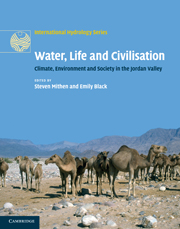Book contents
- Frontmatter
- Contents
- List of figures
- List of tables
- List of contributors
- Acknowledgements
- 1 Introduction: an interdisciplinary approach to Water, Life and Civilisation
- Part I Past, present and future climate
- 2 The present-day climate of the Middle East
- 3 Past climates of the Middle East
- 4 Future climate of the Middle East
- 5 Connecting climate and hydrological models for impacts studies
- Part II The palaeoenvironmental record
- Part III Hydrological studies of the Jordan Valley
- Part IV Human settlement, climate change, hydrology and water management
- Part V Palaeoeconomies and developing archaeological methodologies
- Part VI Society, economy and water today
- Part VII Conclusions
- Index
- Plate section
- References
5 - Connecting climate and hydrological models for impacts studies
from Part I - Past, present and future climate
Published online by Cambridge University Press: 26 April 2011
- Frontmatter
- Contents
- List of figures
- List of tables
- List of contributors
- Acknowledgements
- 1 Introduction: an interdisciplinary approach to Water, Life and Civilisation
- Part I Past, present and future climate
- 2 The present-day climate of the Middle East
- 3 Past climates of the Middle East
- 4 Future climate of the Middle East
- 5 Connecting climate and hydrological models for impacts studies
- Part II The palaeoenvironmental record
- Part III Hydrological studies of the Jordan Valley
- Part IV Human settlement, climate change, hydrology and water management
- Part V Palaeoeconomies and developing archaeological methodologies
- Part VI Society, economy and water today
- Part VII Conclusions
- Index
- Plate section
- References
Summary
ABSTRACT
Driving hydrological models with climate data is a tough challenge – whether the data are from the observational record or climate models. One reason for this is that many hydrological models require long daily time-series of precipitation and evaporation. The scarcity of appropriate observed data in many parts of the MENA region is therefore a potential constraint for the development of such models. Although climate models have the capacity to produce daily time-series for the whole region, the results of impacts studies driven directly by model output would be prejudiced by model error – particularly in precipitation, which is one of the most difficult variables to simulate. This chapter describes how these problems can be addressed by using a simple statistical rainfall model (weather generator) in conjunction with a regional climate model. This enables climate model bias to be corrected, observed monthly data to be disaggregated and the length of a precipitation time-series to be extended.
INTRODUCTION
Driving hydrological models with climate model data provides a key means to understand the hydrological systems of the MENA region, how water availability has changed in the past and how it is projected to change in the future. In cases when it is not appropriate or not possible to use raw model output to drive a hydrological model, a statistical rainfall model (also known as a stochastic weather generator) can be used as an intermediate step.
- Type
- Chapter
- Information
- Water, Life and CivilisationClimate, Environment and Society in the Jordan Valley, pp. 63 - 68Publisher: Cambridge University PressPrint publication year: 2011



